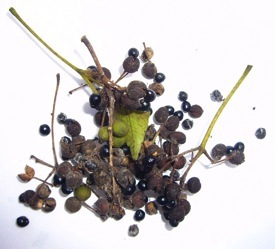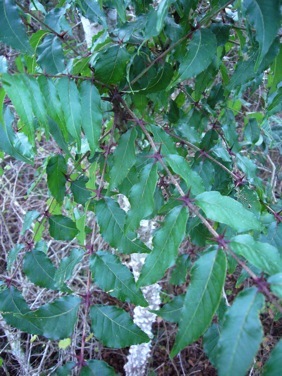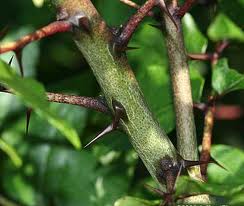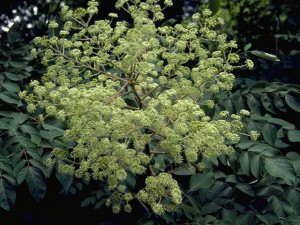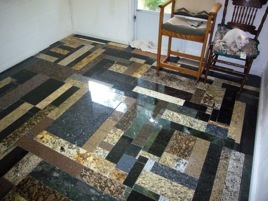Hercules’ Club: Zanthoxylum Clava-Herculis
I sometimes feel sorry for my neighbors, who have lawns of decapitated grass. I’m sure my wild-looking but well-planned yard bothers them but I have the yard of the future, and they of the past.
When I moved into this cul-de-sac house a dozen years ago, it was 1960s suburbanized, read lots of august Augustine lawn, obligatory dwarf legustrums, sago palms (cockroach high rises) and no privet privacy. Since then I’ve managed to get rid of most of the lawn and standard drudgery shrubbery. In their place is an edible landscape, including numerous trees. Every bit of green I’ve planted is consumable in some way, from Amaranth to Zanthoxylum, the latter a magnificent Hercules Club, now some 30 feet high.
The full botanical name for the Hercules Club is Zanthoxylum clava-herculis, which in bastardized Greek — my term for Latin — means “yellow wood club of Hercules.” The roots of The Club are indeed yellow but very weak, not at all Herculean. They are easily broken by hand. Quite odorous, they also appear to be barkless. The “clava” part, the club, comes from Hercules’ weapon of choice, a club that grew spikes, and the Zanthoxylum has spikes: All over its trunk and branches. Mythology aside, The Club has been used to treat toothaches for thousands of years, with a natural kind of topical novacaine found in all parts to varying degrees. The Club also has chelerythrine, which in the lab is effective against resistant staphylococcus, a little nasty bug one picks up in hospitals.
American natives used The Club, for a range of ailments. A bark decoction was used for venereal disease; the bark, wood and leaves for toothaches, and a decoction of boiled roots was also used to increase perspiration. Indians and settlers mixed the inner bark with bear fat and used it as a poultice for ulcers and a treatment for itches. Ripe berries were seeped in hot water to make a spray used in the mouth and blown on the chest and throat for chest ailments. The bark was also used for inflammations of the throat.
What its leaves, bark and roots, taste and smell like is a matter of subjective debate. Some say its smells like lime, others bitter lime. To me it smells just like Ambersol, the toothache application you can buy in drug stores…or …Anbesol smells like The Club. The tree is also covered with thorns which means kids and other climbing animals leave it alone. One creature, however, that is not deterred by the thorns is the the larvae of the giant swallowtail butterfly (Papilio cresphontes). All stages of the caterpillar like the tree. The Club
blooms in early spring. In fact, as I write it is late February and it is readying to blossom. Each tiny flower turns into a fruit that dries and splits to reveal a shiny black seed, see photo upper right. Some folks use the seeds of closely related species, the Prickly Ash (Z. americanum) like hot peppercorns, and some think the seeds from The Club can be used the same way. Personally I don’t think so. Z. clava-herculis
seeds taste medicinal to me, not peppery. I also boiled and dried them as recommend. Again mildly medicinal, no pepper. Some however, heat the seeds in salt then use the salt and seeds as a dipping material.
Surprisingly, The Club is cousin to the non-native citrus. Small world. My particular tree has travelled quite a lot. It was first rescued as a sapling from a bull dozer in Daytona Beach in the early ’90s, Port Orange to be specific. It then spent a few years in Lake Mary, Fl., and a clone from that tree is now in Maitland, some 70 miles from where it started. One doesn’t see them too often but when you do there are usually several around, like a dispersed colony. The national champion is 7.5 feet around, 38 feet high, and currently residing in Little Rock, Ar., USA. Its name is said: zan-THOCK-sill-lum CLAY-va-her-KEW-lis.
Incidentally, if you live in The South there is a grass that can also ease the pain of a toothache, Florida Orangegrass, Ctenium floridanum. (TEN-ee-um flor-re-DAY-um, from the Greek xteni, hah-TEN-nee, meaning comb, read all the seed heads on one side.)
My Club shades my Florida Room, below, which has a trash-bin granite floor ( notice my helper, Oliver Whitecat, in the chair.) Tons of broken and end-pieces granite are thrown away every day. All one has to do is a little dumpster diving to get it. In this case a few early Sunday mornings. Not only do I have a granite floor, but four walkways as well. Now that’s recycling!
One last thing: It is related to Szechuan pepper.
Green Deane’s “Itemized” Plant Profile
IDENTIFICATION: Young growth covered with spikes, leaves alternate, pinnately compound, 7-9 narrowly elliptical to lanceolate leaflets with round-pointed teeth, waxy-shiny above, light green below, 5-8 inches overall
TIME OF YEAR: Inner bark available year round, leaves except for winter. Seeds, summer.
ENVIRONMENT: Well-drained, dry sandy spots, full sun to some shade.
METHOD OF PREPARATION: Leaves and inner bark for topical use against toothaches. Fruit might be used like pepper but this is not an endorsement of that practice. Some heat the seeds in salt (in the oven) and use the mix as a dipping material (like a sauce.) A potentially toxic tree, approach accordingly.


